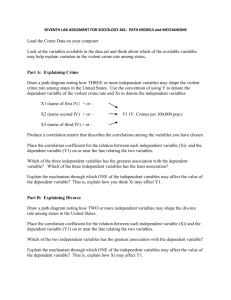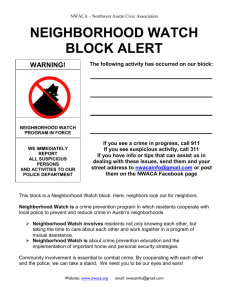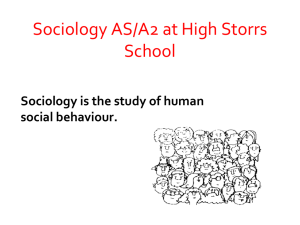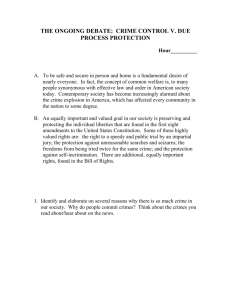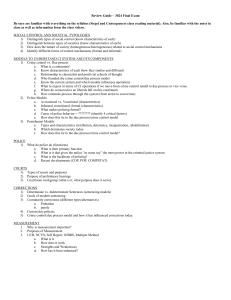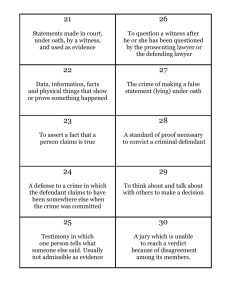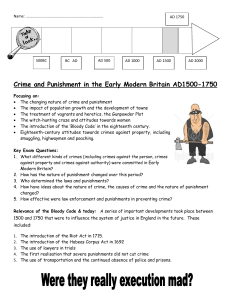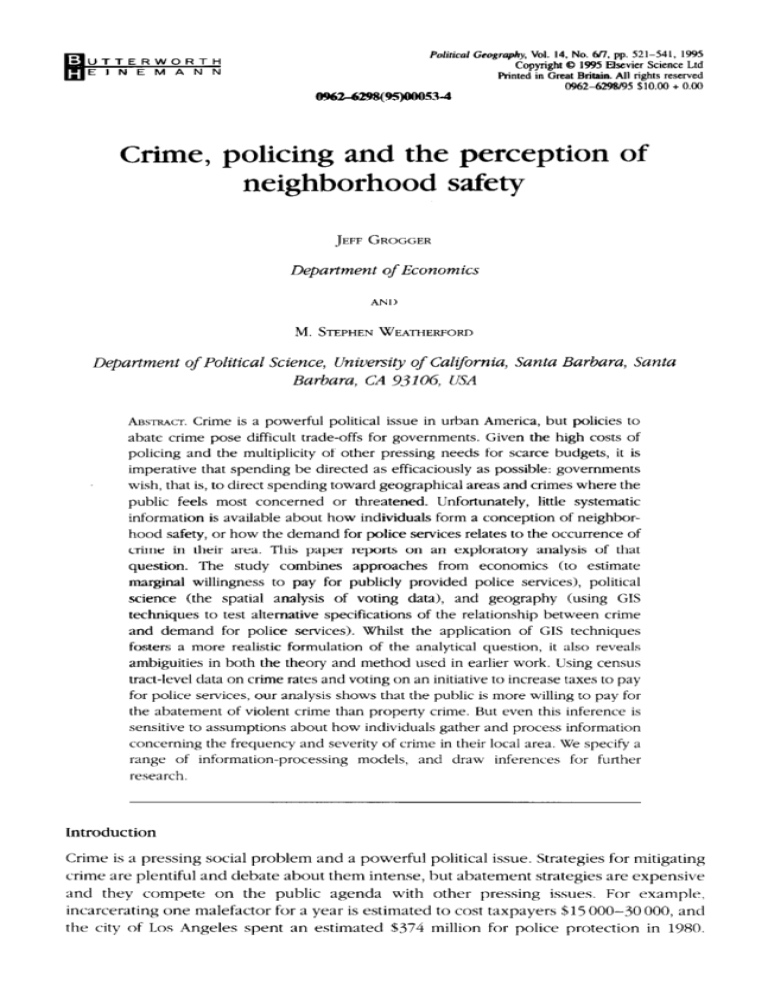
Politico1 Geography, Vol. 14. No. 617. pp. 521-541, 1995
Copyright 0 1995 Rsevier Science Ltd
Rimed in Great Britain. All rights reserved
0962-629fm
$10.00 + 0.00
0!%2-6298(9s)ooo53-4
Crime, policing and the perception of
neighborhood safety
JEFF GROGGER
Department
of Economics
AND
M.
Department
STEPHEN
WEATHERFORD
of Political Science, University of California,
Barbara, CA 93106,
USA
ABSTRK~. Crime is a powerful
political
abate crime pose difficult trade-offs
policing
and the multiplicity
imperative
that spending
issue in urban America,
for governments.
of other pressing
be directed
feels
most
information
concerned
is available
or threatened.
but policies
needs for scarce
budgets,
as possible:
to
it is
governments
areas and crimes where the
Unfortunately,
about how individuals
little systematic
form a conception
of neighbor-
hood safety, or how the demand for police services relates to the occurrence
crime
in their
question.
The
marginal
science
techniques
spatial
combines
ambiguities
tract-level
reports
on an exploratory
approaches
from
to pay for publicly
provided
analysis
data),
for police
of voting
specifications
services).
a more realistic
formulation
Whilst
analysis
economics
police
and
(to
estimate
services),
political
geography
of the relationship
the application
of the analytical
of
of that
(using
between
GIS
crime
of GIS techniques
question,
it also reveals
in both the theory and method used in earlier work. Using census
data on crime rates and voting on an initiative to increase taxes to pay
for police services,
the abatement
sensitive
paper
to test alternative
and demand
our analysis shows that the public is more willing to pay for
of violent crime than property
to assumptions
concerning
range
This
study
willingness
(the
fosters
area.
Santa
Given the high costs of
as efficaciously
wish, that is, to direct spending toward geographical
public
Santa Barbara,
crime. But even this inference
about how individuals gather and process
the frequency
is
information
and severity of crime in their local area We specify a
of information-processing
models,
and
draw
inferences
for further
research.
Introduction
Crime
is a pressing
crime
are plentiful
and
they
compete
social
problem
and debate
on
the
about
public
and a powerful
them
intense,
agenda
with
political
issue.
but abatement
other
pressing
Strategies
for mitigating
strategies
are expensive
issues.
For example,
incarcerating
one malefactor
for a year is estimated to cost taxpayers $15 000-30
the city of Los Angeles spent an estimated
$374 million for police protection
000, and
in 1980.
Crime, policing and the perception of neighborhood safety
522
Given
such
sizable
pronounced.
outlays,
the challenge
of wisely
allocating
scarce
resources
is
Society would wish, that is, to reduce the danger posed by crime by the
greatest amount for a given criminal justice budget. In a democratic
crucial information
needed
by the government
political system, the
would define the public’s aversion
to
different types of crimes. Other things being equal, we would like to spend additional
dollars on crime control to prevent those crimes that society deems most severe.
Such a severity ranking is not one an outside observer can readily make. While it is easy
to state that murder, for example,
is more severe than joy riding, and to rank burglaries
of empty houses based on the value of goods stolen, there are many cases where such a
ranking is considerably
more difficult to make. For instance, the line between assault and
robbery is often blurred-
is a savage beating by itself worse than a mugging that involves
a loss of funds, but less severe bodily injury? While one might attempt a ranking based on
the sum of funds stolen,
entirely the considerable
attempts to characterize
reflect
hospital costs and lost income,
psychic costs imposed on victims. A social welfare function that
the way victims
and their fellow
In this paper, we propose
over different
neighborhood
referendum
protection.
a strategy to obtain
types
of crimes,
that explicitly
linked
the
form psychological
images
and its potential
an ordinal ranking
by examining
increased
of the
impact on
of social (dis-)
the relationship
between
voting patterns
on a Los Angeles
property
with
taxes
We follow a strategy similar to that used by economists
additional
city
police
to estimate marginal
for publicly provided goods.
Our analysis is frankly exploratory,
about
citizens
of the crime problem
crime rates and neighborhood
willingness-to-pay
would miss
the public’s relative aversion for different crimes should, in short,
magnitude and spatial distribution
themselves.
preferences
such a scheme
public’s
beliefs,
one
and the exposition
involving
crime,
interweaves two related themes
the
other
geography.
Our
initial
hypothesis,
drawn from the literature, was that the vote on a measure to increase police
protection
should
neighborhood.
depend
in a fairly direct
way on the crime
The analysis shows that the relationship
more complex
unanticipated
than that hypothesis
subtlety-specifically,
not correspond
implies, because
the geographical
in any simple way to the psychological
between
rate in the voter’s
crime and voting is
‘neighborhood’
is a construct
space environing
of
individuals may
space relevant to their assessment
of crime and personal safety. In a nutshell, we find that the measured effect of crime on
voting
depends
neighborhood
conceptions
potentially
on
the
definition
of
crime rates. The problem
‘neighborhood’
of melding
that
of space occurs in a wide variety of social science
serious impacts on estimation
and inference.
one
geographical
uses
to construct
and psychological
settings, and may have
While earlier researchers
made little progress beyond identifying the problem, the use of GIS technology
have
has made
it feasible for us to pursue the issue analytically.
A model of optimal crime control
In this section we present a simple formal model of optimal crime control. The model
points out the importance
of knowing the social disutility ranking of various crime types
for the formation of optimal criminal justice policy. The exposition is for the most part a
simplification of that in Grogger (1987).
There are two crime types, the levels of which are denoted at c1 and c,. The direct costs
imposed on society in terms of lost and damaged property, time losses and psychic losses
are given by the social disutility function U (c,, c2). Both partial derivatives of U (> are
JEFF GR~GGER AND M.
negative but decrease
police expenditures
at a decreasing
523
STEPHENWEATHERFORD
rate for all values of c1 and c,. Society allocates
to abating both types of crime, and it is assumed that expenditures
can be at least partially targeted toward abating one type over the other. Expenditures
devoted toward crime 1 are denoted by sl, those devoted toward type 2 denoted
The
amount
expenditure,
of each
type
of crime
is related
s,.
abatement
according to two aggregate crime functions. Drawing on previous research,
these can be thought of as the aggregated
who respond
consumption
to the corresponding
to the level of police
first-order conditions
expenditures
of potential criminals,
and to legitimate
employment
and
prospects so as to maximize their expected utility. These reaction functions,
which serve as behavioral feasibility constraints to society, are given as c, = f(sJ,
It is assumed
that A’(s3 < 0 where J;’ denotes
i = 1,2.
the derivative of A. Finally, the budget
constraint of the police is given by K (sl + s2) < i?, where K+ > 0.
Society’s problem
is therefore
to
::‘g L = U(c,, CJ
s.t. cI = d (s,) i = 1, 2
K(s,
The first-order conditions
+ s,) < Ic
for a minimum can be written
.fi’
(s1)
-=_
Y2
f2’
Yl
(s2)
where y, and y2 are the Lagrange multipliers associated
with the first two constraints.
Now, y, is the shadow value of reducing the level of crime i by one unit, expressed
in
social utility units. In other words, it is the social disutility weight attributed to the ith
crime type. The more severe crime type will therefore
condition
can thus be interpreted
the ratio of the marginal deterrent effect of expenditures
deterrent effect of expenditures
have the larger yi. The first-order
as stating that resources
should be allocated such that
on crime type 1 to the marginal
on crime type 2 should be in proportion
to their relative
disutility weights.
The
relative
expenditure
values
of two
factors
are therefore
seen
to influence
the optimal
to control a specific type of crime: the severity of the crime as reflected by
its social disutility weight y,, and its deterability (I;‘). If deterability were equal, then more
should be spent on deterring the more severe crime. Several researchers
have examined
the deterability of different types of offenses (Witte, 1980; Myers, 1983; Grogger, 1991). In
contrast,
there
has been
no research
directed
toward estimating
societal
preference
orderings over different types of crimes. In the next section, we discuss the data we use
in our preliminary estimate of such an ordering.
The data
Data on the number of crimes of different types in the city of Los Angeles are reported by
police reporting district (PRD) on a quarterly basis by the Los Angeles Police Department.
We aggregate the quarterly data to provide annual counts for 1985. The PRDs by which
the data are reported are small geographical units which in many cases coincide with
census tracts (CTs). In most cases where the two units do not coincide, two or more PRDs
nest cleanly within a CT. The data were aggregated
crime counts analyzed below.
by hand to provide the census tract
Crime, policing and the perception of neighborhood safety
524
Data on police expenditures
per capita within Los Angeles are reported on an annual
basis in the LAPD Annual Report. These are provided by police reporting area (PRA), a
larger geographical
unit nesting many PRDs.There
are eighteen PRAs; we use expenditure
data from 1985.
The voting data come from a referendum
1985. The referendum,
improvements
Proposition
on the Los Angeles city election ballot in June
1, would have mandated
to finance the employment
a special tax on land and
of up to 1000 additional police officers over the
period 1985 to 1990. The language of the measure made it very clear that funds raised by
the tax would be used solely for increasing
police patrols and for related support costs.
The measure failed with a ‘no’ vote of about 55 percent.
Precinct-level
voting data on Proposition
1 were obtained
from the Los Angeles City
Registrar of Voters. The Registrar’s Office also provided detailed maps of the voting precincts,
and these were used to hand-match precincts to CTs. In general, CT overlays were used to
determine
the proportion
of each precinct that fell in each tract. About 80 percent of all
precincts fell within a single CT. Tract-level vote tallies were then computed for analysis.
Finally, to control for factors known to be important determinants
ballot measures,
demographic
and income variables from the 1980 Census were taken
from the Census Summary Tape File 3. The temporal
1980 demographic
measurement
omitted
mismatch stemming
from use of
data and 1985 ballot and crime data is doubtless undesirable,
error induced by this temporal mismatch
variable
demographic
of voting on such
bias that would
and economic
occur
is of lesser magnitude
in the absence
but the
than the
of any data on important
control variables.’
The variables to be analyzed are defined and statistically summarized in Table 1. Due
to collinearity
among crime counts,
TABLE 1. Variable
Variable abbreviation
PYES
LOGPYES
VCRIME
PCRIME
POLEXP
PRLACK
I’ASIAN
POTHER
POP
DAYPOP
POPDENS
PCINC
PPOV
the data were aggregated
definitions
and summary
Description
Percentage
ye5 votes out of total votes
cast, 1985
Log-odds
of PYES (i.e. log[PYES/
UOO-PYES)l)
Violent crimes per 1000 resident
population,
1985
Property
crimes per 1000 resident
population,
1985
Police expenditure
per capita, 1985
Percentage
of population
that is black,
1980
Percentage
of population
that is Asian,
19x0
Percentage
of population
that is nonwhite, non-black
and non-Asian
1980
1980 resident population
Number of jobs located in tract in
1980
Resident population
density 1980
1980 per capita income ($lOOs)
Percent of families below poverty line,
1980
into two types: violent
statistics
Mean
45.3
-0.28
9.4
SD
17.4
0.77
14.7
117.5
307.3
125.9
69.9
17.6
29.9
6.8
8.4
12.4
14.8
4051.3
2 410.0
1726.4
4 788.7
10 677.8
87.4
13.6
7 445.0
54.5
11.7
JEFF GROCCER
ANDM.
STEPHEN
525
WEATHERFORD
crimes and property crimes. Violent crimes include murder, rape, robbery
and assault.
while property crimes include burglary, larceny and auto theft.* Both crime variables are
expressed
as rates, giving the number of crimes per 1000 resident population.’
Two sets of explanatory
variables merit particular discussion.
that police
mistreat
members
presumably
would desire lower levels of police protection
all else equal. We therefore
tract as controls
of minority
groups;
include variables measuring
for residents’
preferences.
Second,
A frequent complaint
in this case,
minority
is
members
than their major counterparts,
the racial composition
in each
it may seem natural to include a
measure of housing tenure in the model since the referendum
involved a property tax.
While property taxes are in fact levied on owners, much of the actual tax burden may be
passed on to tenants. In this case, income will provide a better measure of willingness to
pay for increased
police services.
Graphical descriptions
of the vote proportions
and crime rates are provided in Figures
la- lc. In Figure la, for instance, we see that the referendum
in Central and South Central Los Angeles,
generally carried in tracts
and failed in West Los Angeles and the San
Fernando Valley. A relatively strong correlation would appear to exist between
yes votes
and the violent crime rate (Figure lb), with a weaker association between property crime
rates (Figure Ic) and yes votes. Other graphical analyses not provided here indicated that
areas with high proportions
population
densities,
of yes votes also had larger black
populations,
higher
and lower per capita incomes than areas with low yes votes.
Estimation
for police
K5e demand
services
Estimation can be motivated by considering
the individual’s demand function for police
services, For the Ch individual in tract j, demand for police expenditures
is assumed to
take the form
E ‘1* =
Where
zii u
- uq
(1)
E,,* gives desired expenditures,
neighborhood
disturbance
crime rates, income
ZY is a vector of relevant attributes,
and demographic
variables,
including
and Up is a random
term.
While E,,* is not directly observed,
the individual is assumed to vote in favor of the
measure
if E,; > A,, where A1 is actual expenditures
measure
otherwise.
logistically distributed,
With the additional
assumption
in tract j, and to vote against the
that the
u,{ are independently
one obtains the relation
(2)
where p, is the fraction of yes votes in tract j, and Z/contains tract averages of the variables
in ZIr Equation (2) is expressed in terms of observable tract-level variables, and is linear
in the parameters 6. It can therefore be estimated by ordinary least squares (OLS). The
coefficients
of the crime rate variables are proportional
to the average change in desired
police expenditures for a unit increase in the corresponding crime rate, holding all other
factors constant. Presumably, voters’ demands for increased police protection in response
to equal changes in different types of offenses reflect the seriousness they attach to those
offense types. That is, a unit increase in more serious offenses will lead to a greater
Crime, policing and the perception of neighborhood safety
526
m
0.14
to <0.25
m
0.25
to <0.50
q
n
0.50
to <0.75
0.75
to 0.91
n
No data
FIGURFLA. Proportion of yes votes
JEFF GROGGER AND M. STEPHENWEATHERFORD
m
0 to <13.6
q
n
n
13.6
to <25.6
25.6
to <53.2
53.2
to 951
q
No data
The violent
crime data
robbery
and aggravated
include
murder,
assault
FIGIRF 1~. Violent
crimes
rape,
per 1000 resident population
527
Crime, policing and the perception of neighborhood safe&
c
35 to <lo6
@fj 106 to (146
Property
and
q
146 to (200
H
200 to 2850
q
No data
crimes
include
burglary,
larceny
autotheft
FIGURElc. Property crimes per 1000 resident population.
529
JEFF GROCCERANI M. STEPHENWFATHERFORI~
increase
in desired
reason,
the estimated
of different
types
expenditures
crime
than
a unit increase
rate coefficients
in less serious
can be used to construct
crimes.
For this
a severity
ranking
of offenses.
Specifuing the concept of neighborhood
Some
conception
of ‘neighborhood’
individuals’
judgments
individual’s
judgment
of their
or ‘local area’
own
is organized
psychologically
meaningful,
conceptualizing
the geographical
likelihood
must
by a conception
but
the
lie at the
victimized
of the spatial
literature
bounds
logically
of being
offers
little
by
environment
empirical
of this psychological
precincts
or other
comparable
reporting
units
that
have
requirements
spatial
been
bear
space.
crime
defined
rate’
1982a,
individual,
for
demographic
his/her
of those
living
catchment
area for information
localized
within
passively.
More
interpersonal
use attributable
individuals
persuade
each
interactions,
other.
as a surrounding
Some
The mismatch
and
exchange
use surrogate
that constitutes
the opinions
and
homogeneous
are fostered
stations
tend
elite
to be
share. We might think of
that most
residents
that attitudes
exchanges
may
occupations
and patterns
do
little
indicators,
in the
by active
more
than
of information
but many will be contacts
or attempt
no
‘absorb‘
and beliefs
likely to be nurtured
have
of an
individual’s
by the social class, ethnic
information
typically
sciences
of all but a few
radio
residents
or bias, is more
these
the
environments
class or racial composition,
scientists
and thus of necessity
the aggregate
of
only
patterns
condition
of backgrounds,
social
it is a relatively
with its implication
direction
Social
data
that give a
opinions
of opinion
news-and
that neighborhood
the
influences
Local information
of television
purposively
the level of the tract or voting
that
areas
to a neighborhood’s
in which
whose
like the ‘relevant
political
not
The environment
circulation
of opinion’,
conversations.
data are available.
processes
across
but also the climate
on local and regional
the commonality
relevant to
tracts, voting
agencies,
or the
measure
media-the
commonality
local area carry an identifiable
acknowledge
for
pointedly,
only for geographical
of concepts
studies
vote
to
and opinion.
environment
The ‘climate
the
it, to the extent
broadcasting
and to concentrate
or other demographic
the informational
affiliation
of the mass
the
effects
environment.
behaviors
and
the spatial component
it is conventional
traits and partisan
newspapers
of public
and cultural
in contextual
social psychological
by the economics
convenience
to the social
198217). In predicting
instance,
record
that is
as a neighborhood.
over how to specify
is encountered
(Weatherford,
for the
identity
public
finds that data are available
little or no relation
area its particular
The ambiguity
areas for which
typically
of
The
guidance
there is virtually no reason to believe that the images of ‘neighborhood’
citizens’ reckonings
about personal
safety are coterminous
with Census
At the same time, the analyst
heart
crime.
direct
to influence
measures
such as census
data at the level of the precinct,
in order
or
of these
information
at
to typify some
of
traits of the area.”
of available
spatial
data and social psychological
reality poses
problems
for both theory and method. Theories about how people form opinions or make political
choices
clearly err by treating
each person
as a monadic
individual;
attitudes
and
behaviors
are the products
of encounters
between
separate
beliefs but also the need to test the accuracy of their beliefs
their opinions)
and their social surroundings
(composed
less predictable
encounters>.
To test and develop theories
individual
and society, we need measures
of the social
individuals
(with their own
and to gain approbation
for
of some mix of self-selection
and
about the interaction
between
context.
I!sing available data.
Crime, policing and the perception of neighborhood safety
530
almost
certainly
measured
on area1 units that lack much
‘psychological
reality’,
is
preferable to omitting contextual variables altogether; but the practice may simply replace
one specification
problem
with another,
properties lead to errors-in-variables
since
problems
inappropriately
(Weatherford,
measured
we present the results of our analysis of GIS data to investigate systematically
alternative
specifications
of the spatial context
contextual
1982a). In the next section,
that environs
a range of
citizens’ thinking
about
different types of crime.
Results
The results of estimating Equation (2) from tract-level data are presented
Although
these models
account
for a high proportion
voting data, with an R2 of 0.73, their implications for model specification
Model 1, including
the control variables
along with a measure
census tract, reveals a sizable, properly signed coefficient
likelihood
of voting
worrisomely
for Proposition
in Table 2.
of the variation in tract-level
are inconsistent.
of violent crime in the
for the effect of crime on the
I, but the standard
error of the coefficient
is
large. Model 2 substitutes a measure of property crime and shows a small but
significant effect of crime on the vote. Taking these two models together, we might infer
that violent crimes have about 10 times the impact of property crimes on individuals’
demand
for police
protection,
but that the measurement
It might
are artificial, however, since both types of crime occur in the real world and
individuals’ views of personal
be
objected
(or our
specifications
influence
is imprecise.
crime
of its causal
both presumably
impact)
of violent
specification
that these
safety in the neighborhood.
Model 3 includes the two crime variables along with the control variables. The results for
property crime in this specification
appear plausible,
but the sign of the coefficient
violent crime is wrong and its standard error is excessive.
either problems with the specification
problems with the data, presumably
of the relationship
on
These symptoms might signal
between crime and the vote, or
collinearity between the two crime variables.5 In this
section and in Appendix A we investigate each possibility seriatim.
Do different crimes take place in different ‘neighborhoods’?
Our measurement
procedure
of the crime rate variables in the models above follows conventional
in contextual
effects studies, aggregating
all the variables at the level of the
census tract and then using the tract as the unit of analysis. This specification
voters had in mind information
about the occurrence
TAHLF2. Regression
Variable
VCRIME
PCRIME
Adjusted @
Model 1
0.207 (0.142)
0.730
results: dependent
implies that
of crime in their census tract, when
variable is LOGPYES
Model 2
Model 3
0.018 (0.006)
-1.69 (0.190)
0.023 (0.008)
0.733
0.733
Notes. * Coefficient (x100), standard error.
Mohel 1 includes VCRIME and control variables, Model 2 includes PCRIME and controls, and Model 3
includes both VCRIME and PCRIME along with the control variables. The control variables include POLEXP,
PASIAN, PBLACK, POTHER, POP, DAYPOP, PCINC, AND PPOV
JEFF GROCCER AND M. STEPHEN WEATHERFORD
they voted on the proposal
531
for higher taxes to fund more police protection.
Intuitively,
however, we have little reason to believe that the basis for assessing one’s exposure
crime comes
from the crime committed
solely within one’s tract of residence.
to
This is
particularly likely given that the average area of a census tract in Los Angeles is only 1.7
kma, the area corresponding
to a circle with a radius of only 730 meters, or less than half
a mile. This seems well below
the typical distance
one would travel, say, on routine
shopping trips, and even children who walk to school (about whose safety many voters
are likely to be acutely concerned)
on average. Moreover,
crime
spending
problems
measures,
in adjacent
are likely to traverse a greater distance than half a mile
voters’ expectations
about crime, and hence their votes on anti-
might reasonably
be based
on information
about
crime
areas, since these may spill over into their own neighborhood.
Individuals’ assessments
of personal
safety, in short, are unlikely to be bounded
area as small as a census tract; it would be reasonable
for their perceptions
by an
of the relevant
crime rate to take in a wider area.
To test this intuition empirically, we constructed
larger areas, and then included each sequentially
of prior information
constructed,
each
crime rate measures over successively
in the regression
model. Given the lack
as to the proper area to be included, a series of such measures was
indicating
the crime rate over an area whose
radius was a given
multiple of ~1,where p is the radius of a circle with area equal to the average area of a tract.
From the discussion
corresponding
above, then,
[J
is roughly 730 meters. Specifically,
to k’p for k = 1 to 5, in increments
total number of crimes committed
FIGIXE 2. Census
tracts
of 0.25, computing
we defined areas
crime rates as the
in tracts whose centroids fell within a circle of radius
and neighborhoods
in South-Central
Los Angeles
Crime, policing and the perception of neighborhood safety
532
@I from the centroid of the target tract, divided by total resident population over the same
area.’ Figure 2 illustrates these areas for a representative
tract.
Table 3 presents the results of estimating the model of Table 2 with various different
measures
of the crime rates. Note that the number of observations
models varies across the specifications.
whose centroids lay within /+Iof the city boundaries.
deletion
of the first Iz observations
distributed lag, and the consequences
The operation
from a time-series
model
is analogous
containing
are identical: fewer observations
The spatial definition of ‘neighborhood’
the results are generally
(x100), using different definitions
to the
a kth-order
for larger Iz.
takes in roughly the same-sized
for census tracts, and, as might be expected,
TABLE3. Crime coefficients
used to estimate the
This is due to the necessity of deleting observations
area for 1~ as
similar to those
of neighborhood
Coefficient and standard error
Neighborhood radius, in
multiples of mean tract
radius
Model A(l)
VCRiME
0.072
0.071
0.133
0.08
0.127
0.08
0.124
0.104
0.162
0.126
0.217
0.158
0.253
0.172
0.445
0.185
0.765
0.237
1.197
0.307
1.879
0.398
2.036
0.416
2.362
0.424
2.451
0.432
2.807
0.471
.?.29_?
0.476
3.554
0.504
1.00
1.25
1.50
1.75
2.00
2.25
2.50
2.75
3.00
3.25
3.50
3.75
4.00
4.25
4.50
4.75
5.00
Note; Coefficient
Model A(l)
PCRIME
is in italics above,
standard
error below.
N
0.016
0.007
0.106
0.008
0.015
0.008
0.043
0.017
0.178
0.04
0.142
0.042
0.139
0.044
0.182
0.047
0.275
0.059
0.391
0.074
0.574
0.075
0.654
0.102
0.705
0.103
0.791
0.105
0.852
0.112
0.975
0.116
1.042
0.122
Model specifications
match
those
571
552
532
504
481
456
442
429
406
389
376
365
351
343
324
313
270
in Table 2.
JEFF GROGGER AND M.
computed
using census
in Model
differs
the two specifications.
across
The
specifications,
remaining
significance
masked
levels.
relationship
degree
neighborhood
tract. Models
rate in a larger
and
In Appendix
crime
to take
to affect
cases.
estimates
and
substantive
the pattern
interpret
effect
difficult
the evidence
A, we review
to
on the
the evidence
of
the area of the ‘neighborhood’
a series of spatial contexts
1 and 2 provide
area
point
on the analysis.
between
is increased
of the
in the data that makes
rates and voting.
relationship
from zero in both
from a coherent
we present
and of similar
of the VCRIME coefficient
in terms
impact qf crime on the vote: defining
of the
census
estimate
we believe,
section,
its impact
Model 2 and the PCRIME coefficient
different
both
results,
Recall that our goal in simulating
pattern
widely
533
for PCRIME is significant
the point
of collinearity
crime
and assess
i%e ua ying
vary
In the next
between
collinearity
While
This variation
statistically.
effect
it is insignificantly
estimates
by a certain
isolate
tract crime rates. Comparing
3, we can see that the estimated
size across
STEPHENWEATHERFORD
rates
in a larger
and
the
and larger
the clearest
the vote,
of varying
and
picture
vote,
sizes is to track the
as the
size
area surrounding
of the effect of allowing
we focus
on those
of the
the voter’s
the crime
specifications
in this
section.
Note first that the summary
expectations.
series:
the higher
increasing
the crime
rate,
comports
the whole
range,
with
the more
crimes
average
based
for PCRIME (0.411). The pattern
moreover,
to reveal
additional
The pattern
insight
of the impact
of crime
crimes
from 0.07 to 3.6, while
grows
the relative
the entire
will fAvor
magnitude
of the
of the crime: over virtually
powerful
on the vote than property
effect
(1.287)
about
of coefficients
three
times
the
across the simulations
voters
conceptualize
their
as the size of the area increases,
The coefficient
average
appears.
spatial
the strength
for the rate of violent
crime rate increases
are more readily
seen graphically,
and Figures _ia and
.3h chart
of the crime
and we think significant
coefficients
difference
against
~1. These
figures
in the pattern
of effects
of the two types of
display
an
on voting.
In Figure .?a we see that the coefficients
violent
crimes
2.50, increasing
which
in the area
for the property
patterns
crime
are in line with
across
the coefficient
from 0.016 to 1.04. These
intriguing
Similarly,
on the vote also increases.
the magnitude
that the vote
into the way
is unmistakable:
specifications
on the severity
coefficient
coefficient
environment.
likely
have a more
VCRIME
by these
on the vote is consistent
protection.
with expectations
violent
the
revealed
of crime
taxes to pay for more police
coefficients
crimes.
properties
The sign of the impact
voters
it comes
steadily
over the remaining
about
their residential
crimes,
events
citizens
range.’
on the vote of the rate of
This suggests
the rate of violent
of violence
appear
the impact
of p, and then begin
is not so much
but rather the awareness
to violent
showing
small for small values
are responding
neighborhood,
information
is quite
at about
~1 =
that the information
to grow
to
crime
in the immediate
in the larger surrounding
to define
in a quite large area (within
their
personal
a radius of about
area, When
safety
in light of
2.5 miles) around
block.’
Figure .?b shows
that the pattern
of estimated
coefficients
for the impact
of the rate of
property
crimes on the vote differs from the pattern for violent crimes. Like the violent
crime rate, the rate of property crimes in the immediate
neighborhood
has little effect on
the vote (see Figure _?b), but the rise in the coefficient
occurs
earlier
(/I = 1.75) and the
pattern shows a notable spike at /I = 2.0, where the size of the effect levels off until about
{! = 2.75. This suggests that voters may be responding
to a psychologically
coherent sense
Crime, policing and the perception of neighborhood safety
1
t.25 I5
FIGURE 3~.
1.75 '
2.25 2'5
2.75 '
3.25 3'5
3.75 4
4.25 4'5
4.75 5
Coefficient of VCRIME as a function of neighborhood radius in Model
(PCRIME omitted).
1
1.2
1
0.8
0.6
0.4
0.2
0
1.25 1'5
FIGURE 3~.
1.75
4
3
2
1
2.25 2'5
3.25 3'5
2.75
3.75
5
4.25 4'5
4.75
Coefficient of PCRIME as a function of neighborhood radius in Model 2
@CRIME omitted).
of ‘neighborhood’
at about p = 2.0-2.75
(a circle with radius roughly a mile), in addition
to taking account of information about property crimes in a larger area around where they
live.
The stylized pattern
research
literature
of coefficients
on information
observed
flow
here is interpretable
and political
paradox in the findings of Table 3 is the suggestion
opinionization.
that the psychological
more severe crime resonates across a larger ‘neighborhood’.
in light of the
The
apparent
impact of the
With property crimes, that is,
the greater their frequency in contiguous and nearby surrounding areas, the greater the
citizen’s support for expenditures on policing. With violent crime, on the other hand,
greater
frequency
in the local area appears
policing, while greater frequency
to make
little difference
to support
for
in a relatively large region surrounding the individual’s
residential tract does translate into more votes for anti-crime spending.
We can see the explanation for this pattern by returning to the notion of the
neighborhood
context as a catchment area in the flow of information. It is a truism to
remark that individuals shape their opinions from what they know of reality, and that if
subjective perceptions and objective circumstances differ, then it is the perceptions that
influence attitudes and actions. The truism carries special weight in our case, for it
535
JEFFGROCCERAND M. STEPHENWEATHERFORII
appears
highly
different
sources
reporting
likely
that individuals
than for property
on different
obtain
information
about
violent
crime, and the different transmission
area1 units, paint systematically
different
crime
from
channels,
by
pictures of the spatial
surround relevant to assessing personal safety. The dramatic nature of violent crime draws
television coverage,
crimes. Television
and television is a key source of citizens’ information
personalizes
information,
bringing
about violent
into the living room stories that
carry the immediacy of local events. But television skews the presentation
of crime in two
ways: it presents as ‘local news’ events drawn from a catchment area much larger than the
census tract or the immediate neighborhood,
and especially
perception
of violent
crime
(Sheley
and it exaggerates
and Ashkins,
the frequency
1981).
Thus,
of crime
the subjective
of violent crime, on which the individual’s vote is based, correlates with data
on actual crime rates for a much larger urban environment
than the individual’s census
tract.
Property crimes, on the other hand, are both less exciting and less unusual than violent
crimes
(especially
coverage.
in a large metropolis),
Thus the bulk of information
from local newspapers
communities
and they garner
genuinely
little television
and personal contact. Dramatic property crimes from surrounding
are by no means excluded
from the individual’s attention (and they are
likely to arrive at the individual’s consciousness
alongside
relatively
about property crimes comes to the individual
local
events
about
via television),
which
but they take their place
information
comes
from
personal
contacts.
Differences
in the dominant
source of information
help to explain why the correlation
between
crime is significant when the relevant context
the impact of the property
about different crime types, then,
the vote and a measure of actual property
is as small as the census tract, and why
crime rate is especially
pronounced
for an area just a bit
larger than a mile wide (a size that strikes us as intuitively consistent with the traditional
image
of a neighborhood).
Local
media
and personal
conversations
information.
The impact of the property crime rate for increasingly
the relevant
spatial context
transmission
flow-television
steadily
rising effect
is, conversely,
probably
and metropolitan
of the violent
crime
attributable
newspapers-that
rate on the vote
transmit
this
large definitions
of
to the same sort of
accounts
as the spatial
for the
area
is
widened.9
Conclusion
and directions
for further work
Our analysis set out to construct
a social preference
ordering
over two qualitatively
different types of crimes, and the results strongly suggest that citizens are much more
sensitive to violent crime than to property crime, as shown by their willingness
additional taxes for police protection.
our ability to express
Both theoretical
this as an unambiguous
and statistical challenges
conclusion,
to pay
hamper
but the results have strong
intuitive appeal and substantial statistical support. The theoretical puzzle concerns a
problem of long standing in social scientists’ research on contextual effects: how to
provide a valid spatial definition of the concept of ‘neighborhood’.
arises from the procedure
presence
of collinearity
of aggregating
between
information
The statistical problem
from multiple area1 units, in the
key variables.
To bring empirical evidence to bear on defining the notion of ‘neighborhood,’ we have
employed GIS data and analysis resources to investigate the way in which individuals
Crime, policing and the perception of neighborhood safety
536
map their ‘psychological space’ depending on the practical problem they are confronting.
We begin from the intuition that ‘neighborhood’ is not a constant construct. For instance,
the relevant notion of neighborhood
would differ depending on whether one needed to
borrow a cup of sugar or form an opinion on alternative locations for a nuclear waste
facility. We test this intuition in a structured comparison, focusing on the public’s reaction
to different types of crime. Even though we hold constant the general subject-matter,
crime and law enforcement,
and the outcome variable, voting on a ballot proposition,
nevertheless
a subtle pattern of differences emerges between the area1 extent of
‘neighborhood’ that individuals use in evaluating violent crime versus property crime. The
observed pattern is, moreover, consistent
with what we know from media and
information use studies of the flow of news in urban areas, and thus we conjecture that
information flow conditions the area1 extent of individuals’ psychological conception of
locality.
We address the methodological
puzzle by utilizing our GIS data to simulate a
succession
of neighborhoods
of varying size, and then to track and compare
systematically the effects of aggregation across units and collinearity between variables.
Our analysis, reported in Appendix A, supports our decision to rely on separate
regressions for each crime type in evaluating the substantive question of the public’s
relative sensitivity to different crimes. These results lead to the interpretation that both
types of crime are important determinants of the public’s demand for police protection,
but that violent crimes carry the greater causal weight.
In future work, we wish to build on the ordinal-level distinctions revealed by this
research, to refine the model in two directions. One will pursue more extensive
experimentation
directed toward establishing empirical criteria for the proper specification of the construct of ‘neighborhood’ that citizens use implicitly to give psychological
meaning to crime rates. The other will extend the analysis by investigating whether spatial
dependence
in the model disturbances may hinder efforts to obtain precise estimates of
the crime rate coefficients.
Acknowledgements
An earlier version of this paper was presented at the NCGIA Conference
Models
of Political
Behavior,
gratefully acknowledged.
Buffalo,
New York,
22-25
October
Rusty Dodson has provided excellent
on Spatial and Contextual
1992. Support
from NCGIA is
research assistance.
Thanks are also
due to Dick Berk for providing the crime data and to Munroe Eagles for his constructive
as discussant
comments
at the conference.
Notes
1. In future work, we plan to use the 1980 and 1990 Census data to interpolate 1985 values of these
variables
for a sample
of comparable
areas,
in order
to assess
the
seriousness
of this
mismatch.
2. We note that different offense types within these two categories
concern
among voters. In particular,
concerned,
reported
in spite of its relative
infrequency.
We therefore
estimated
models
below in which we used the murder rate as the crime variable.
qualitatively
therefore,
may well differ in the level of
murder is a crime about which the public seems acutely
very similar
we present
to the models
which
included
all violent
only the models which include the broader
such as those
These models were
crimes.
crime rates.
To save space,
JEFF GROGGER AND M. STEPHENWEATHERFORD
3. Note
that we can
centered
place
only
assess
the effect
on the area of residence.
of employment;
unavailable,
4. Sprague
detailed
one would
data matching
tracts
vote
of crime
also like to measure
of residence
in neighborhoods
crime
with tracts
around
of work
one’s
places
are
however.
and Huckfeldt,
significant
progress
Huckfeldt
in a major data collection
at depicting
and Sprague,
5. The magnitude
pooling
on the referendum
Ideally,
537
measures
operation-that
project
and a series of insightful
of information
and
influence
articles,
in the
local
make
area
(cf.
rules
out
1987, 1988).
and statistical
the two
flows
voters
significance
into
of the difference
an omnibus
do not distinguish
‘crime’
between
between
variable,
violent
the coefficients
even
crime
if the implication
and
property
of this
crime-were
acceptable.
6. While
in principle
the centroid,
one might
the unweighted
of accounting
for crime
wish to down-weight
crime
occurring
will see, even use of the simple
for serious
of model
additional
complexity
7. The coefficient
does
is consistently
H. The radius
beyond
not reach
significant
could
actually
occurring
constructed
the boundaries
unweighted
consideration
add needless
crimes
rate variables
variables
selection
criteria.
conventional
of the individual’s
poses
problems
The choice
and is, therefore,
at a greater
distance
here demonstrate
levels of statistical
own
tract.
of interpretation
of weighting
left for future
from
the importance
As we
that call
schemes
would
work.
significance
until p = 2.75 and
after that,
be larger,
but the data do not permit
us to estimate
models
with larger
areas.
9. An alternative
concerned
explanation
of the greater
not only with crime
their workplace)
and
residence.
this alternative
While
for neighborhoods
IO. This
clustering
the larger
larger
from that of violent
around
crime
of census
than
importance
neighborhoods
hypothesis
3~, it does
for areas
tract
about
properties
Central
South
parts
References
reflects
these
is that citizens
are
of the city as well (e.g.
areas
the increase
why the impact
the
distinguishes
of the metropolis
Valley and on the West Side.
parts
as well as the area
in the crime
of property
of
coefficients
crime
differ\
one mile in diameter.
Here it essentially
Fernando
encompass
not explain
in Los Angeles.
Central
neighborhoods
but in other
may explain
segregation
and
of larger
their homes,
from
relatively
poor
high
degree
of residential
and working-class
the more
affluent
districts
areas
in the
in the San
Crime, policing and the perception of neighborhood safety
538
Appendix
A: The Problem
of Collinearity
among
Crime
Rates
By regressing the vote on each type of crime separately, Models 1 and 2 produce a coherent and
plausible picture of the process through which citizens translate their information about crime into
political demands for more police protection. Both these specifications are, however, liable to the
accusation that they omit a correlated, and substantively relevant, independent variable (i.e. PCFUME
from Model I and VCRIME from Model 21, and hence that their coefficient estimates may be biased.
Model A(1) addresses this possibility, by including both crime rate variables along with the control
variables. The estimates from this specification, presented in Table Al, tell a more ambiguous story
about the relationship between crime and the vote. Whether the data for the regression are tract-
TABLEAl. Crime coefficients
(x100), using different definitions
of neighborhood
Coefficient and standard error
Neighborhood radius, in
multiples of mean tract
radius
Model A(lj
VCHME
-0.084
0.104
0.011
0.133
-0.001
0.137
-0.104
0.144
-0.925
0.0215
-1.118
0.328
-0.954
0.352
-0.829
0.384
-1.021
0.518
-0.63
0.581
0.083
0.627
-0.03 7
0.655
0.245
0.691
-0.222
0.704
0.089
0.757
0.688
0.732
0.906
0.758
1.00
1.25
1.50
1.75
2.00
2.25
2.50
2.75
3.00
3.25
3.50
3.75
4.00
4.25
4.50
4.75
5.00
Note Coefficient
Model A(1 j
PCIUME
is in italics above,
standard
error below.
N
0.022
0.01
0.015
0.013
0.015
0.013
0.054
0.024
0.425
0.069
0.407
0.088
0.356
0.091
0.368
0.098
0.505
0.131
0.523
0.142
0.558
0.152
0.661
0.164
0.657
0.17
0.836
0.177
0.834
0.185
0.84
0.184
0.867
0.19
Model
specifications
match
571
552
532
504
481
456
442
429
406
389
376
365
351
343
324
313
290
those
in Table 2.
JEFF
GROGGER
ANDM.
STEPHEN WEATHERFORD
539
level measures (see Table 2) or built indicators summed over successively larger areas (see Table .?J
the impression is the same: the coefficients for PCRIME are generally significant and consistent with
the estimates derived from Model 2, while the coefficients for VCRIME are unstable (though typically
indistinguishable
from zero) and vary widely from Model 1. We suspect that the explanation for
these perplexing results is a combination of measurement error and multicollinearity, and in this
Appendix we investigate the symptoms for that diagnosis.
Collinearity, the problem of excessively strong correlation among independent
variables, is
difficult to diagnose and nearly impossible to solve. We know, for instance, that occurrences of
violent crime and property crime are correlated, but intuitively the two types of crime appear to have
such different impacts on their victims that concatenating them would misconstrue the causal
process. Statistical tests of collinearity attempt to give some precision to ambiguities like this one. To
check for collinearity, we ran the series of diagnostic tests designed by Belsley et al. (1980). In
pursuing this lead, our use of GIS data allows us to identify the occurrence of collinearity with some
precision, We present the clues in two steps: the first follows the conventional path of contextual
analysis in placing sole reliance on data aggregated at the level of census tracts, the second focuses
on data aggregated up to larger units that appear to be more typical of the spatial area people
identify with the concept of neighborhood.
In Table Al, the results for Model A(I), a conventional analysis of tract-level data on crime rates
and voting, seem to show that citizens are willing to pay higher taxes in order to combat property
crime, but that the effect of violent crime on voting for the measure is indistinguishably different
from zero. This unexpected
result makes it logical to look more closely at measurement
and
specification, In the census tract crime data (N = 727), VCRIME and PCRIME are correlated at r =
0.708, a strong but not clearly fatal relationship. Dimensional analysis of the 11 independent
variables reveals two dominant principal components: one typified by high rates of violent crime,
high expenditures on police, low income and high poverty rates; the other by high rates of property
crime and low population density.‘” Among collinearity diagnostics, the highest condition number
is only 14.9, the progression of condition numbers is quite smooth, and neither VCRIME nor PCRIME
load highly on the offending component. In sum, although the coefficient for VCRIME when Model
A(l) is estimated from tract-level data is unexpectedly paltry, its lack of robustness does not seem
to be attributable to collinearity. We suspect that the small effect is due to a relatively weak signa-tonoise ratio for the VCRIME variable (attributable to measurement error), although we are also aware
that the result may indicate that voters connect violent crime to political expression in a more
complicated way than our model envisions. In future research we hope to investigate both
possibilities.
The more elaborate estimates of Model A(1) shed additional light on this problem. Given the
relatively strong correlation between VCRIME and PCRIME in the smallest units of aggregation (Y =
0.708 in the data for census tracts), if the mechanics of aggregating tracts into larger units were to
increase this correlation, they could undermine the efficiency of our estimates of causal effects.
We pursue a collinearity analysis for the case of the neighborhood radius set at p = 3.0. This case
was selected in part because it is intermediate in the succession of variations on the definition of
neighborhood-as-census-tract,
and in part because the estimated results contradict intuitive
expectations. The diagnostics clearly show that estimation is hampered by correlations among key
independent variables. In this reduced sample (N = 4061, VCRIME and PCRIME are correlated at
K = 0.88. Principal components
analysis of the independent
variables reveals one dominant
component, typified by high rates of both violent crime and property crime and by high poverty
rates, and a weaker second component clustering high expenditures on police with low population
density. Among collinearity diagnostics, the highest condition number is 25.8. approaching the
range of strong and potentially harmful collinearity. This indicator is also nearly double the next
largest, and both VCRIME (0.904) and PCRIME (0.939) load highly on the offending component. In
short, the surprising estimates for this level of aggregation (SuhStdntial positive effects for property
crime, large negative effects for violent crime) are no ground for inference about voters’ reasoning
or the optimal choice of public policy: they are apparently the aherrant result of excessive
correlation between the two types of crime in the data analyzed.
540
Crime, policing and the perception of neighborhood safety
Given the potential theoretical value of obtaining empirically validated estimates of individuals’
conceptions of neighborhood, it is worth investigating further the sources of variation in the degree
of collinearity. Aggregation could worsen the problem of collinearity in either of two ways. One is
a sample composition effect, the other an aggregation effect,
The sample composition effect is caused by dropping observations that border on the city
boundary, a problem that parallels the loss of initial and concluding observations in time series
analysis. In both cases, the number of observations lost is a function of lag length (in our case, ~1.
Recall that the simulations presented in Model A(1) would be based ideally on the same number of
centroids as there are census tracts, but that data for key variables are not available on contiguous
tracts outside the city boundary. This means that, as the area1 units become successively larger, more
tracts must be dropped from the analysis for lack of data. Given the irregular shape traced by the city
boundary, this effect produces a noticeable drop-off in sample size as p increases. The upshot is to
introduce a confounding source of imprecision into the analysis: depending on the pattern of
exclusions, it might turn out that the composition of the resulting sample disproportionately
represents tracts where VCRIME and PCRIME have above-average correlations, thus exacerbating
the problem of collinearity.
The aggregation effect is a direct result of the procedure of summing across census tracts, Given
that the sample is most heterogeneous in the smallest units, summing across census tracts will result
in more homogeneous units, in much the same way that averaging diminishes variance. In addition,
however, larger neighborhoods overlap, while census tracts are mutually exclusive, and this reduces
heterogeneity because the crime rates in different neighborhoods
are computed on the basis of
partially shared data. It is important to note that this effect is essentially the result of faithfully
operationalizing the concept of neighborhood in a densely populated urban area: individuals living
in one census tract are exposed to events in contiguous UXtS both through personal experience and
through the flow of information, and it is natural to suppose that this exposure might result in a
shared sense of concern about personal safety.
In general, changes in sample composition accompany changes in the definition of neighborhood, so that these two possible sources of collinearity cannot ordinarily be disentangled. However,
it is possible to hold one fixed and vary the other, and in this way to distinguish between the two
with a straightforward test, Table A2 presents the results of a re-estimation of Model A(1) in which
the sample composition is varied while the definition of neighborhood is held constant. That is, we
specify the model in terms of tract-level crime rates (as in Model 3, Table 21, and then estimate the
model for the various subsamples resulting from increasing p (as in Model A(l), Table Al).
The coefficients are in every case quite similar to those presented in Table 2. In other words, it is
not primarily changes in sample composition, but rather the process of aggregating to produce
different definitions of the relevant crime rate for different definitions of neighborhood, that leads
to the observed increase in the level of collinearity.
TABLEA2. Regression
l!J
5
3P
5p
-0.169
(0.89)
0.023
(2.97)
715
733
-0.201
(1.01)
0.022
(2.75)
570
0.720
-0.204
(1.13)
0.023
(2.62)
481
0.699
-0.237
(1.07)
0.034
(2.76)
406
0.678
-0.127
(0.49)
0.025
(1.95)
290
0.684
PCRIME
N
Adjusted Z?
(a)
Absolute
(b)
It is the
Cc)
Regressions
variable is LOGPYES
Census tract
VCRIME
Notes.
results: dependent
t-statistics,
radius
based
of the
also
on
circle
include
the
OLS
with
standard
area
control
errors,
in parentheses.
equal
to average
variables
mted
tract
in Tuhle
area,
2.
ahlut
730mL.
JEFFGROGCERAND M. STEPHENWFNHERFORI)
541
We read this result as supporting our decision to focus on Models 1 and 2, which specil;i
separately the effects of different crime types on the vote, in order to interpret the policy
implications of the public’s aversion to violent crime versus property crime. That is, if the level of
correlation between VCRIME and PCRIME is high enough to be pathologically collinear, then
relatively little independent information is lost by estimating vote functions including only one of the
crime variables at a time, as in Models 1 and 2. Thus, the diagnosis of the data problems hampering
sound estimation of a combined mode1 strengthens the underpinning of our interpretation on the
basis of separate estimates.


